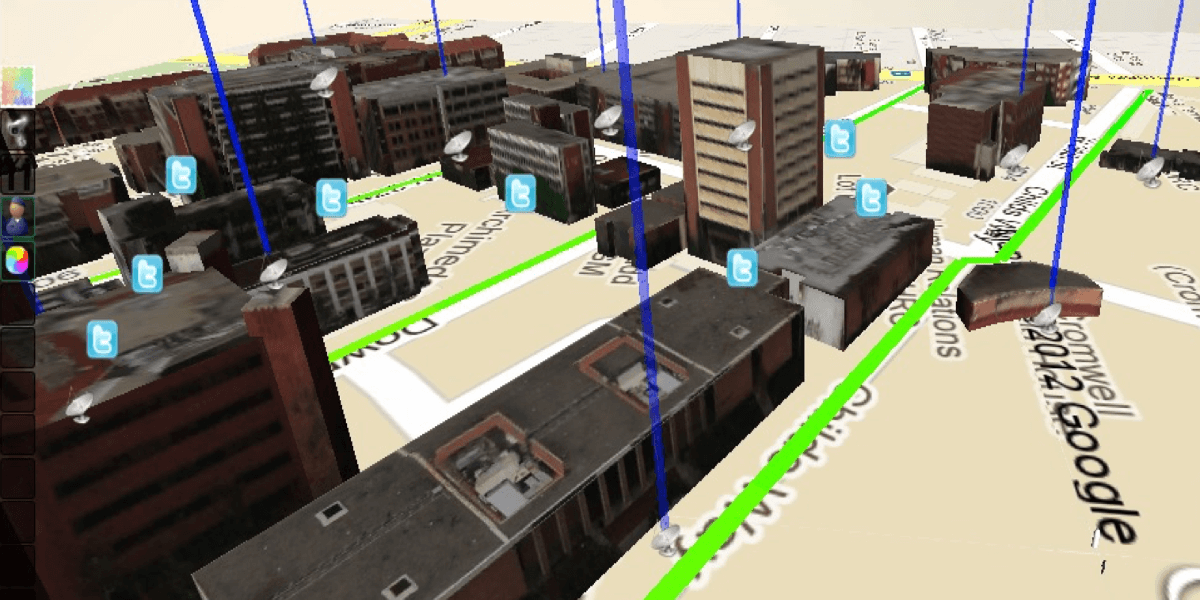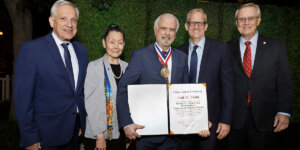
A campus rendering showing satellite uplinks (blue lines) and Twitter feeds. Photo/Azad Madni
Typically, we make decisions after gathering all the necessary information and coming up with different options. We then choose a course of action that is likely to lead to the desired or best outcome.
For simple decisions, like choosing what to wear based on the weather forecast, picking the best option is fairly straightforward. However, for complex engineering problems such as smart manufacturing, production engineering, and real-time aircraft diversion planning, the considerations and possibilities are overwhelming. Furthermore, problems of this magnitude involve a large number of people from diverse backgrounds, such as systems engineering, finance, and program management, making communication and collaboration challenging.
Azad Madni, executive director of the Systems Architecting and Engineering program and professor of astronautics, created an innovative solution that engages all involved parties, helps them develop a shared understanding of the problem, and allows them to collaboratively explore options with different assumptions before making informed decisions together. His method: interactive storytelling.
“Instead of a free-flowing adventure, stories in engineering strive to achieve certain desirable outcomes” – Madni
“Stories in literature are meant to engage you and evoke certain emotional responses from you,” said Madni. “Here, in complex systems engineering, stories are purposeful, interactive narratives constructed around the system being designed. Instead of a free-flowing adventure, stories in engineering strive to achieve certain desirable outcomes, in terms of desired system behaviors, with a minimum of unintended consequences. And we do that in the most engaging way possible to sustain team involvement.”
To create a story, Madni begins by using system models and data pertaining to each of the involved components to create and populate a virtual world. Take the example of an aircraft that needs to be rerouted to land on a different runway due to inclement weather. Using data about flights, weather and ground personnel, as well as capabilities and constraints of the plane, runway and geographical location, a 3-D rendering of the system is brought to life in a virtual world using a video game engine.
Users can view and interact with the visual scenes, causing the story to unfold in particular ways. They can explore different scenarios based on their own what-ifs: What if the weather gets worse? What if that backup runway is unavailable? What if the airport at the destination is understaffed?
By making these worlds adaptable, stakeholders are able to steer the story through their interactions with the system, thereby cultivating a better understanding of the system’s behaviors and limitations. After observing how each story plays out from the perspectives of the different stakeholders, they are better equipped to make informed, collective decisions in the real world.
“You can collaboratively explore alternate futures with different assumptions and technologies” – Madni
Madni likens this approach to taking “sneak peeks” into the future.
“You can collaboratively explore alternate futures with different assumptions and technologies. You can decide which outcomes you like or want, and which you don’t,” he said. “You use that knowledge to share proposed fixes and introduce those that you agree on as a group.”
In his book, Transdisciplinary Systems Engineering: Exploiting Convergence in a Hyper-Connected World, Madni employs a popular approach called “science fiction prototyping.” By creating an envisioned prototype of a proposed system, you are able to see how the system would play out in the real world. Once you have converged on a solution, you can then build that system prototype in the real world and expect to achieve a similar outcome.
However, Madni cautions that the full benefits of this approach will only be realized as technologies mature over time. And, of course, the most crucial factor in these model-based, data-driven approaches is having access to data.
“The accuracy of the models depends on how broad or specific your questions are and your access to the data,” said Madni. “If you’re looking for rough cut answers, then the data can be partial and approximate and you can still get good answers. But as you need to answer more detailed questions, you need increasingly more detailed models and that requires more detailed and accurate data.”
Madni has been engaged in advancing this field for well over a decade, improving upon his virtual world construction and visualizations as technology has progressed. When he joined USC in 2009, he brought this research with him.
“I use video games and storytelling as engineering tools and tradeoff decision aids to engage stakeholders, to get things better understood and to explore uncertain futures” Madni said. “If a picture is worth a thousand words, and a model is worth a thousand pictures, then a story is worth a thousand models.”
Published on July 14th, 2017
Last updated on September 13th, 2017












